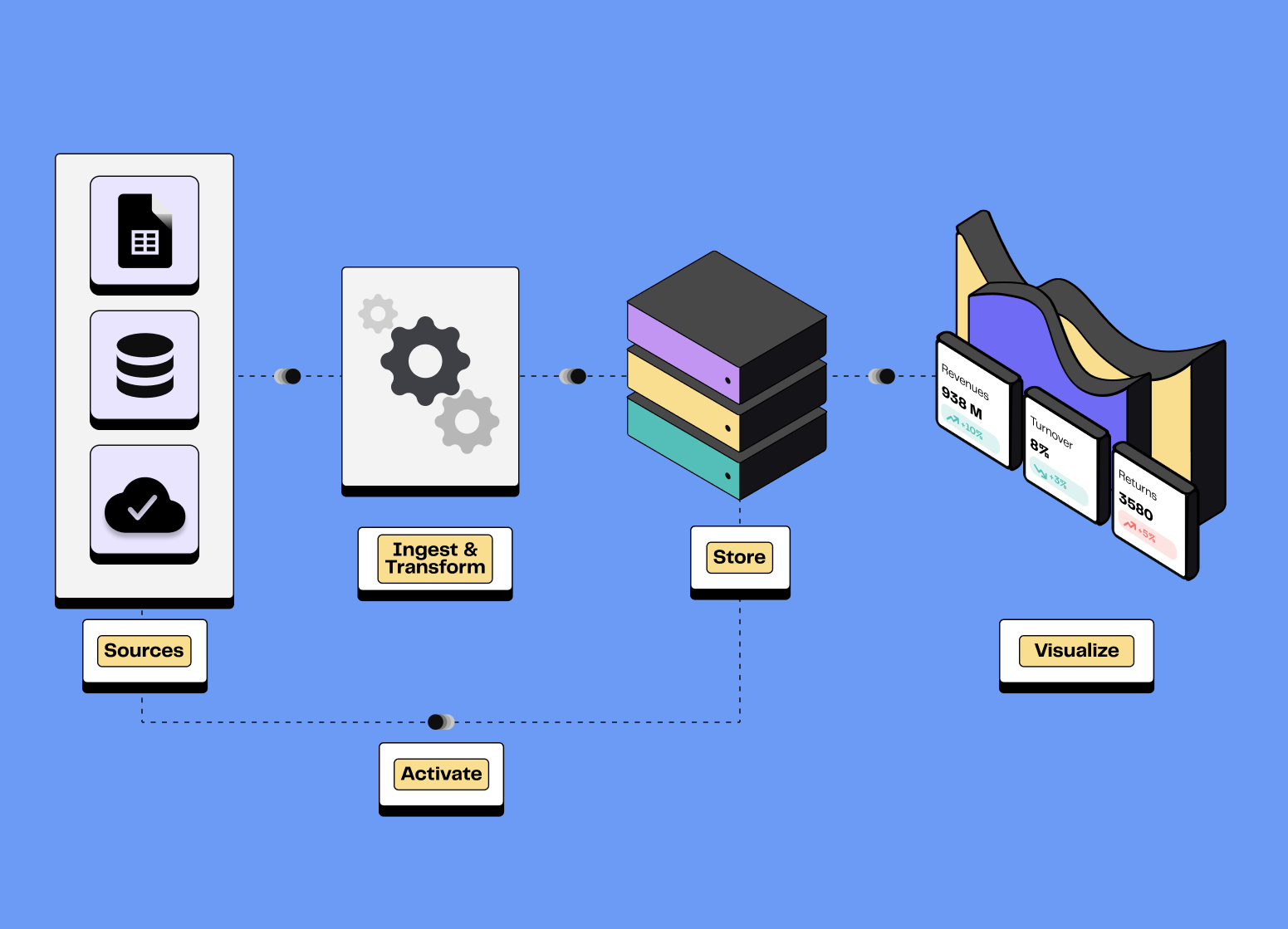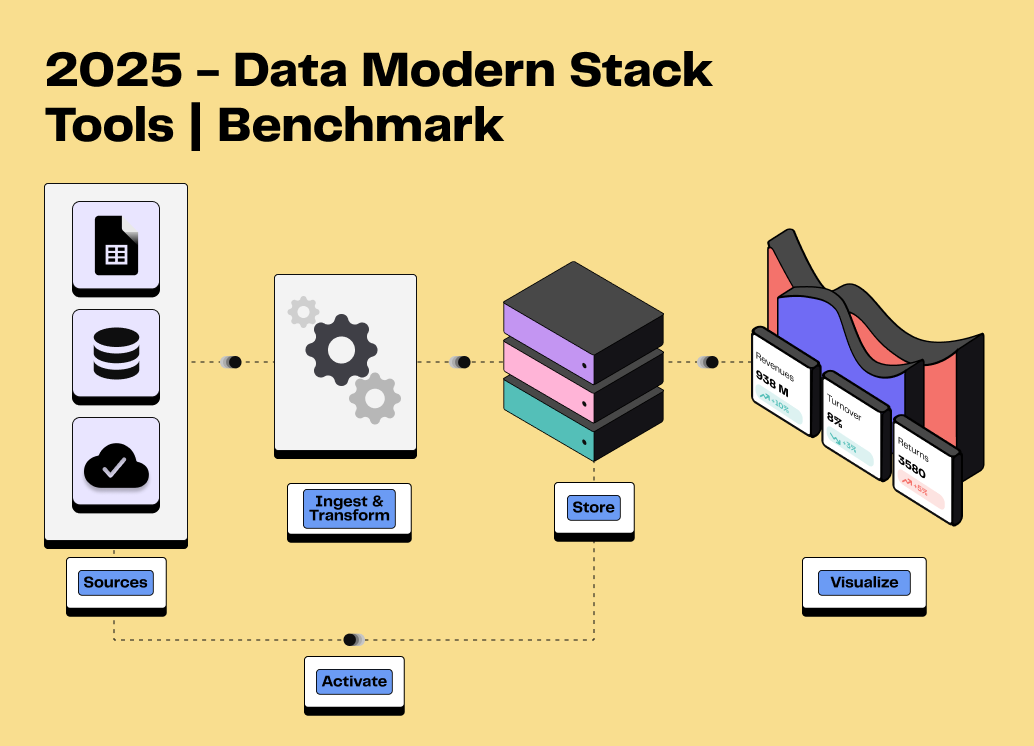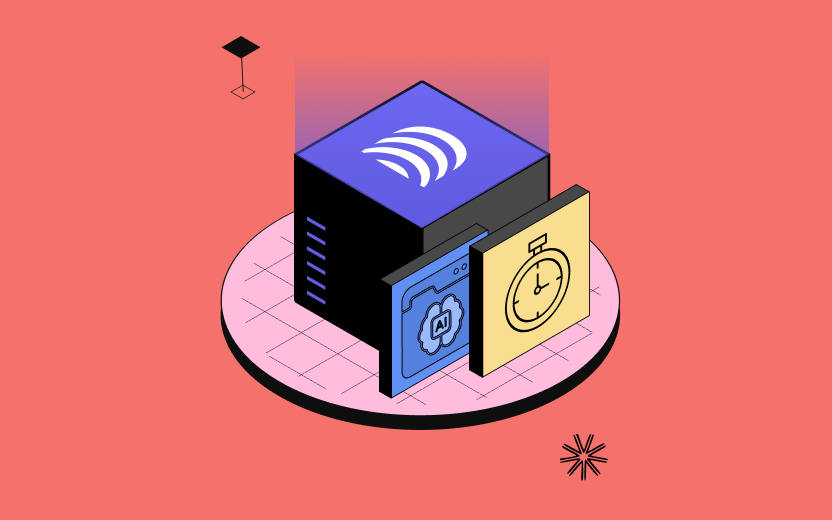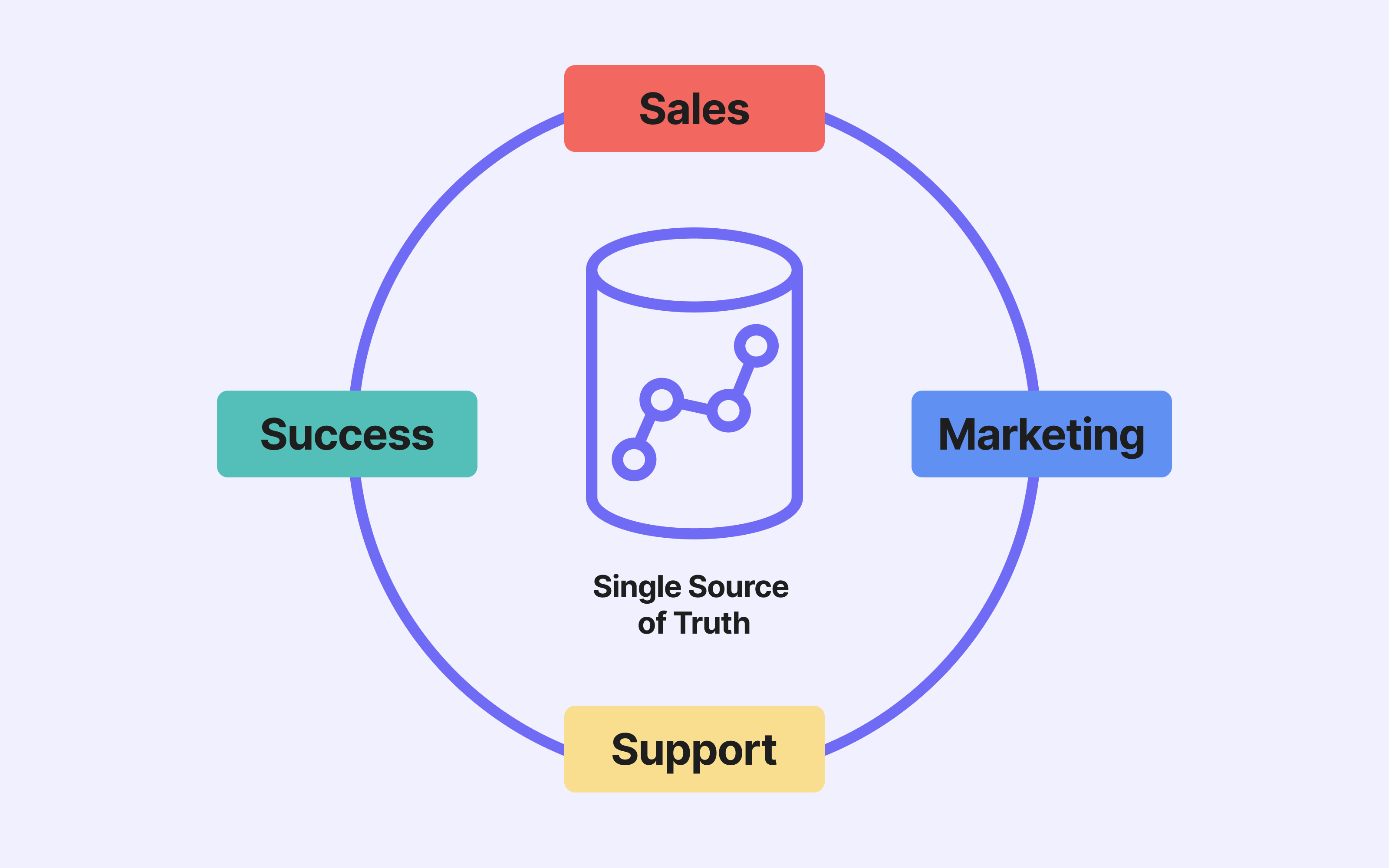
Why your CRM shouldn't be your source of truth
6min • Last updated on Sep 24, 2024

Alexandra Augusti
Chief of Staff
The CRM (Customer Relationship Management) system has long been used to manage relationships with customers, prospects, and partners.
However, customer relationships have become more complex over time due to an increase in touch points and a growing need for personalization. In this context, the necessity for a Single Source of Truth (SSOT) - centralizing all customer interactions - has intensified.
I know - a CRM can already centralize a significant amount of information about prospects and existing customers. But, sorry to break it to you, a CRM alone is not sufficient as a Single Source of Truth. With the emergence of the Modern Data Stack, the data warehouse is now the best option for SSOT.
In this article, we will detail:
What a Single Source of Truth is and why it is indispensable for your business
Why a CRM cannot be the SSOT
How new approaches using Customer Data Platforms (CDP) enable a SSOT while overcoming existing constraints
What is a Single Source of Truth?
The term Single Source of Truth (SSOT) refers to the principle of a single source (e.g., a central platform) that concentrates accurate, comprehensive, and up-to-date information about a company's activities. This data forms the foundation upon which the organization relies and is made available to all relevant stakeholders.
The ultimate goal of the Single Source of Truth is to ensure consistency and reliability of data across the organization by relying on a single, reliable source of information, eliminating all silos within the company. This principle ensures that decisions, reports, analyses, and dashboards based on this information are relevant.
A Single Source of Truth also eliminates potential errors caused by data dispersion across various platforms: duplicates, incorrect data, or outdated information.
Companies that adopt a Single Source of Truth benefit from an undeniable advantage: they optimize their data usage, improve their efficiency, and make informed decisions thanks to a deep understanding of their data.
Why a CRM cannot be this Single Source of Truth
Even though a CRM (Customer Relationship Management) efficiently assists in managing and improving your relationships with customers and prospects throughout their journey, it cannot be used as a SSOT.
Not all data is in a CRM
CRMs tend to focus on "static" information about your customers, such as contact details (name, address, etc.). However, this information does not provide a complete picture of your customers' behavior, needs, and expectations. A significant amount of dynamic data in an actionable format is missing, especially the data obtained through customer interactions with your brand, products, or services.
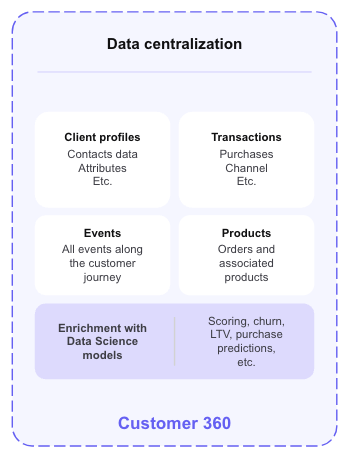
All the information we recommend centralizing in a Single Source of truth
For example, knowing which web pages your customers visited, what actions were taken on the app, and which products were purchased is crucial for personalizing your marketing content and improving the customer experience.
⚠️ Do not misunderstand: a CRM can contain this information. Of course, integration solutions exist (API, iPaaS, etc.), but they can be cumbersome to implement and maintain to ensure 100% of the data is captured, especially in the case of custom pipelines.
Even if this data is transferred to the CRM, it is often in an unusable format. Having a list of pages viewed by a customer is good, but knowing "the number of high-conversion probability pages visited in the last 7 days" would be way better.
Data analysis with a CRM is a challenge you might not want to face. However, having aggregated data is much more useful for customer segmentation and data activation!
CRM data is not always up-to-date
Information in your CRM is generally updated manually by sales teams, which inevitably opens the door to human errors, delays, duplicates, and inconsistencies. Sure, automated workflows can be set up in a CRM, but this does not eliminate the large volume of manual tasks (notes after a meeting, qualification done by a salesperson, etc.).
Additionally, the lack of synchronization between CRM data and other company data can lead to discrepancies and conflicts. If a customer's contact information changes, is this update reflected uniformly across all your internal systems? Without this update, you risk losing contact with the customer or sending inappropriate communications.
The CRM is not designed to communicate with other marketing tools
Faced with large volumes of data, a CRM can show weaknesses in terms of performance and security. The more data you integrate into your CRM, the more you risk slowing it down. All this for unusable data most of the time!
Another weakness of the CRM is the lack of connectors to integrate its data with external platforms (advertising, support, etc.), creating silos within the rest of the marketing team and limiting the possibilities for effective targeted campaigns.
The CRM only stores data about known individuals
A CRM cannot record data about individuals who are not yet listed in your CRM but have shown interest in your brand. If a visitor clicks on one of your ads, browses your site but does not download content, you cannot find them in your CRM. These prospects are essential for growing your customer base. The collection, segmentation, and use of their data in effective acquisition strategies is essential.
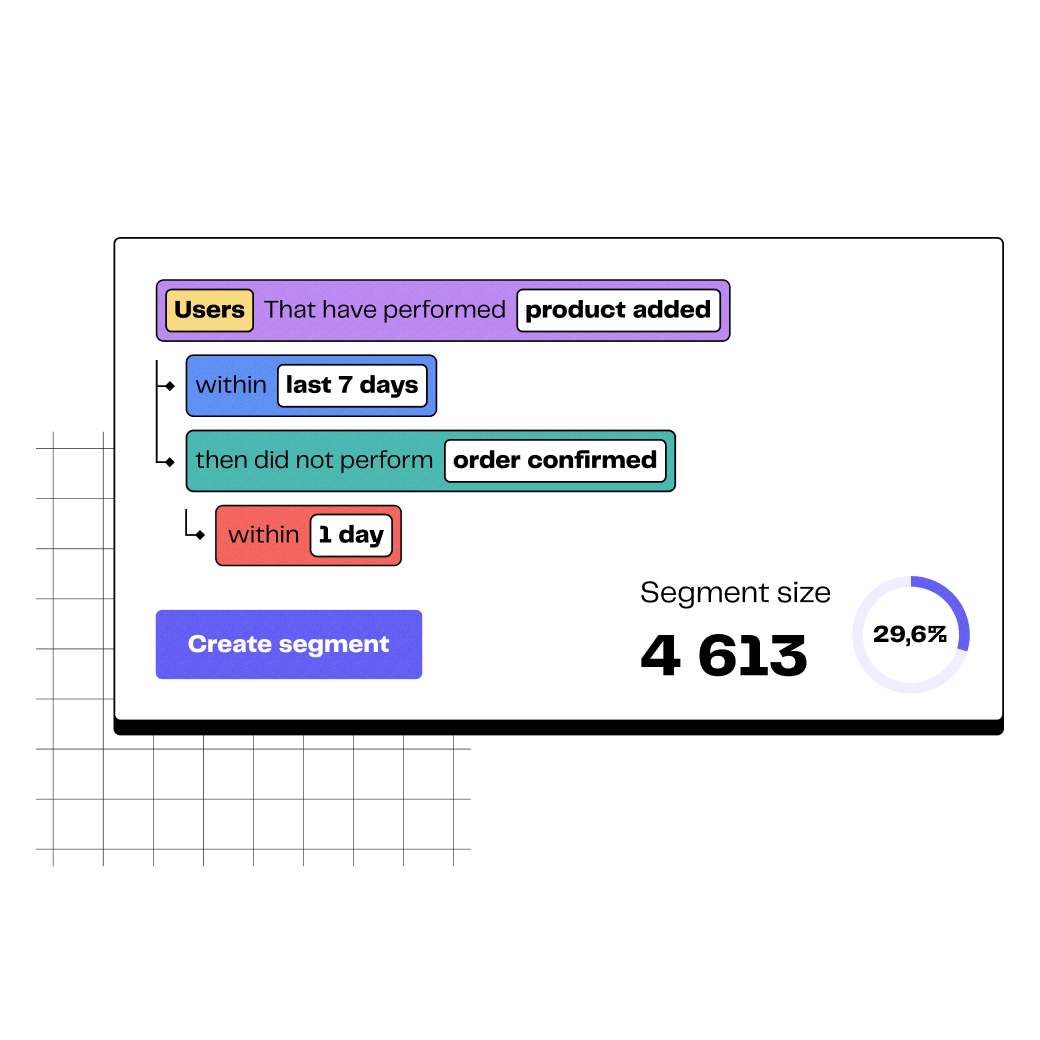
With your SSOT, you should be able to craft segments of visitors who added a product to their cart, without buying it
Does the CDP answer the need for a Single Source of Truth?
The Customer Data Platform (CDP) emerges as a choice solution for aggregating, unifying, and activating customer data from various communication channels, including internet, mobile, social networks, and emails. By doing so, companies gain a complete and integrated 360° view of their customers through the creation of unified profiles and personalized segments. It is tempting to use it as a Single Source of Truth!
Unlike CRMs, the CDP stands out as a Single Source of Truth, notably through its many advantages:
It can collect customer data not only from various internal but also external sources. All first-party data can be collected, allowing tracking of previously unknown individuals to the company.
It can handle large volumes of data without sacrificing performance or security.
It has numerous connectors facilitating integration with a wide range of complementary tools, including CRMs, marketing automation platforms, social media advertising solutions, and analytics tools.
However, traditional versions of CDPs have certain limitations. They can offer limited flexibility, imposing a predefined data model that may not align with the specific needs of each company. Additionally, the implementation and maintenance costs of a traditional CDP are significant, not to mention the fees associated with licenses and necessary updates.
Last but not least, in most cases, your data is duplicated in their operational system, which creates another source of truth.
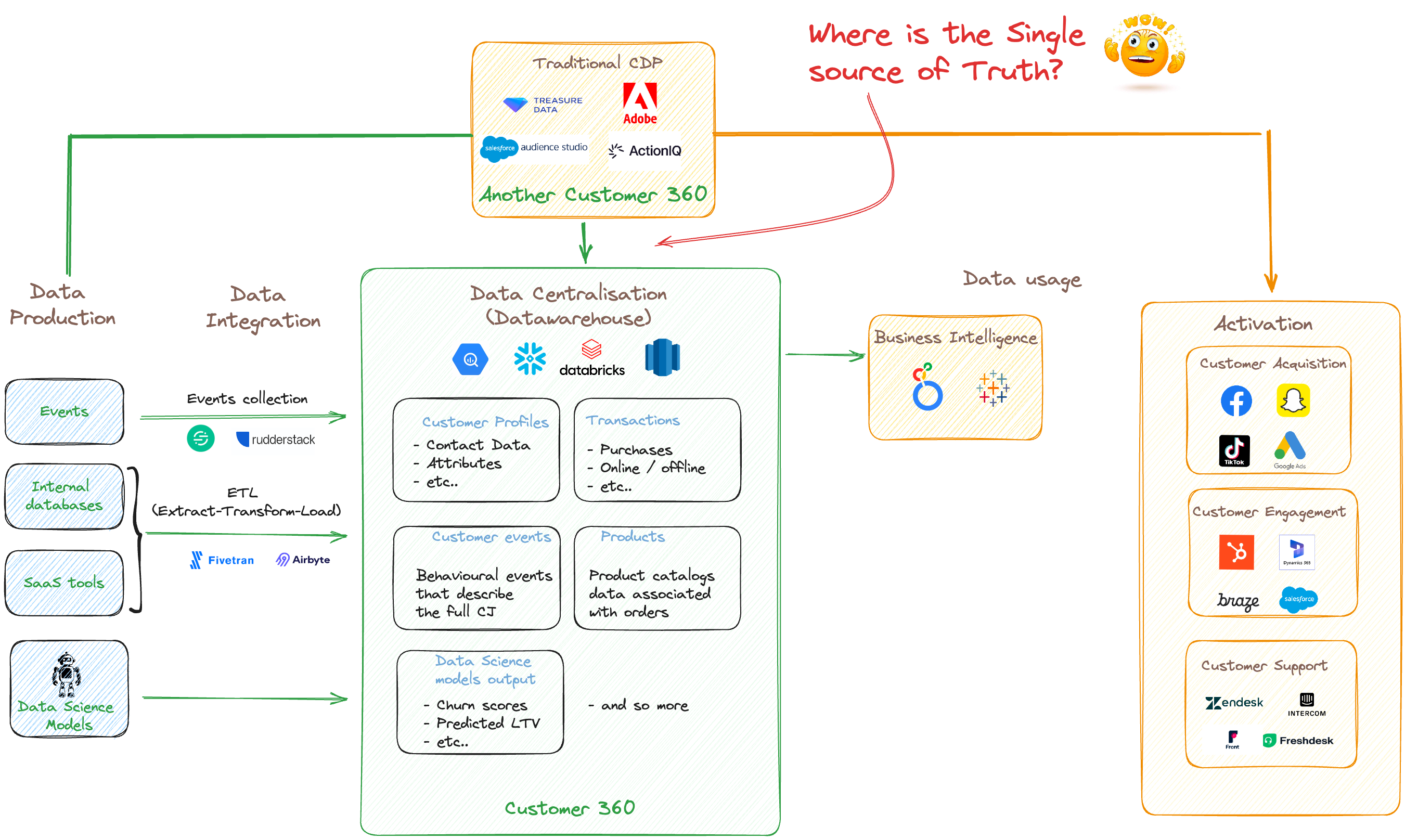
Traditional CDPs duplicate data, negating the concept of "Single Source of Truth"
Implementing a traditional CDP can also be challenging, requiring close coordination between technical teams, marketing, and sales, as well as adequate user training.
👉🏼 This is why I recommend adopting a composable approach to the CDP to address these limitations while retaining the advantages of such a platform (for the SSOT and much more!). You can choose different tools from the Modern Data Stack to build your own Customer Data Platform! Adopting this "best of breeds" approach will give you several advantages:
You stay the owner of your data
You stay the owner of the way you model your business
You can choose any tool for each component of your platform = you can choose the best option for every component
Each component can be purchased independently = you only pay for what you actually use
Your Single Source of Truth should be your data warehouse
In my opinion, the ideal option to achieve a Single Source of Truth is to adopt a cloud data warehouse, which centralizes all information from various sources in a structured format and is ideally optimized for conducting in-depth analyses.
The advantages of a data warehouse are numerous compared to other storage solutions. With the evolution of cloud computing and storage solutions, they have become very accessible and offer a scalable and flexible solution that can perfectly adapt to your needs.
Moreover, data integration pipelines (ETL or ELT) are now user-friendly, allowing effortless transfer of 100% of data from different sources (CRM, billing system, internal applications, etc.) to the data warehouse. This automated integration process saves time and eliminates the need for specialized technical skills while enabling the centralization of 100% of the data related to your business.
Thanks to data transformation tools (like dbt), organizing and modeling from the data warehouse is simplified, allowing the creation of a 360° customer view, coherent and directly actionable by marketing teams.
Centralizing customer data in a data warehouse also facilitates the transfer of this data to operational tools (advertising platforms, CRM, support tools, etc.) via the Reverse ETL process. This functionality allows you to activate your data and use it to design personalized marketing campaigns, strengthen customer relationships, refine your product offering, among other things.
💡All the data bricks mentioned below are widespread tools in the modern data stack. Consult our article to learn more about this approach and discover our benchmark of solutions.
The approach of combining a data warehouse and a Reverse ETL process is called Composable CDP. It offers a modular platform that collects, models, and activates customer data from your existing cloud data infrastructure.
The Composable CDP leverages the data warehouse's repository, which already contains a detailed map of the customer journey. Rather than functioning as a separate entity, it integrates seamlessly with any existing data stack.
Conclusion
A Single Source of Truth ensures consistency, accuracy, and reliability of data, enabling maximum exploitation to refine companies' marketing, sales, and product strategies.
However, not just any tool can be used as a Single Source of Truth: neither the CRM nor the traditional CDP is truly satisfactory in addressing this issue, as they face challenges in data volume or integration (CRM) or flexibility and cost (CDP).
Therefore, to realize your Single Source of Truth, we recommend using a data warehouse, which offers a SSOT that is flexible, performant, and secure to centralize, consolidate, and activate your data.
If you want to learn more about the Modern Data Stack, data warehouses and Composable CDPs, do not hesitate to contact us!













